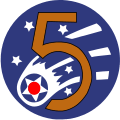69th Bomb Squadron
| 69th Bomb Squadron | |
|---|---|
 Emblem of the 69th Bombardment Squadron | |
| Active |
1940–1991 2009-present |
| Country | United States |
| Branch | United States Air Force |
| Type | Squadron |
| Role | Bombardment |
| Part of |
5th Bomb Wing Eighth Air Force Air Force Global Strike Command |
| Garrison/HQ | Minot Air Force Base |
| Nickname | Knighthawks |
| Colors | Gray/yellow |
The 69th Bomb Squadron is an active United States Air Force unit. After being inactivated on 1 September 1991, it was reactivated on 3 September 2009 at Minot Air Force Base, and assigned to the 5th Bomb Wing. The squadron operates B-52H aircraft.
History
Established as a pre-World War II GHQAF bombardment squadron; equipped with B-18 Bolos and early-model B-26 Marauders. After the Japanese Attack on Pearl Harbor, squadron was engaged in antisubmarine operations over the mid-Atlantic coast. Reassigned to Third Air Force and equipped with A-26 Invader light bombers; deployed to Fifth Air Force in Australia in 1942 as part of the re-equipping of that command after its withdraw to Australia after the 1941-1942 Battle of the Philippines.
Deployed to South Pacific Area (SPA); being assigned to Thirteenth Air Force and attacking enemy targets in the Solomon Islands; New Hebrides and other enemy locations north and east of Papua New Guinea. Became part of Mac Arthur's New Guinea campaign, supported Army ground forces with tactical bombing of enemy formations and targets along the northern coast of New Guinea and in the Dutch East Indies.
Attacked enemy forces in the Philippines during early 1945 as part of the liberation from Japanese control; continued combat missions until the Japanese capitulation in August 1945. Became part of the Fifth Air Force forces in Occupied Japan in 1946 before being demobilized and inactivated in May 1946.
Reactivated as a Strategic Air Command B-36 Peacemaker bombardment squadron in 1953. Engaged in worldwide training missions with the B-36 until 1956 when re-equipped with the jet B-52 Stratofortress. Deployed to Western Pacific during the Vietnam War and flew conventional Arc Light bombardment missions over enemy military and industrial targets in North Vietnam. Returned to the United States and maintained nuclear alert until the end of the Cold War; Inactivated in 1991 with the drawdown of US Strategic forces.
Reactivated in 2009 as part of Air Combat Command and transitioned to Air Force Global Strike Command in early 2010.[1]
Lineage
- Constituted 69th Bombardment Squadron (Medium) on 20 November 1940
- Activated on 15 January 1941
- Inactivated on 10 May 1946
- Redesignated 69th Bombardment Squadron (Heavy) on 19 February 1953
- Activated on 25 February 1953.
- Inactivated on 1 September 1991
- Redesignated 69th Bomb Squadron
- Activated in 3 September 2009
Assignments
- 38th Bombardment Group, 15 January 1941
- 42d Bombardment Group, 26 February 1943 – 10 May 1946
- 42d Bombardment Wing, 25 February 1953 – 1 September 1991
- 5th Bombardment Wing, 3 September 2009–present
Stations
|
|
Aircraft
- B-52H Stratofortress (2009–present)
- B-52G Stratofortress (1959–1991)
- B-52D Stratofortress (1957–1959)
- B-52C Stratofortress (1956)
- B-36 Peacemaker, (1953–1956)
- B-25 Mitchell, (1942–1946)
- A-26 Invader, (1942–1946)
- B-26 Marauder, (1941–1943)
- B-18 Bolo, (1941)
See also
- United States Army Air Forces in Australia
- USAAF in the Battle of Midway
- List of B-52 Units of the United States Air Force
References
![]() This article incorporates public domain material from websites or documents of the Air Force Historical Research Agency.
This article incorporates public domain material from websites or documents of the Air Force Historical Research Agency.
- ↑ "AIR FORCE GLOBAL STRIKE COMMAND". USAF Fact Sheet. Retrieved 31 May 2013.
- Maurer, Maurer, ed. (1982) [1969]. Combat Squadrons of the Air Force, World War II (reprint ed.). Washington, DC: Office of Air Force History. ISBN 0-405-12194-6. LCCN 70605402. OCLC 72556.
External links
| |||||||||||||||||||||||||||||||||||||||||||||||||||
| |||||||||||||||||||||||||||||||||||||||||||||||||||||||||||


